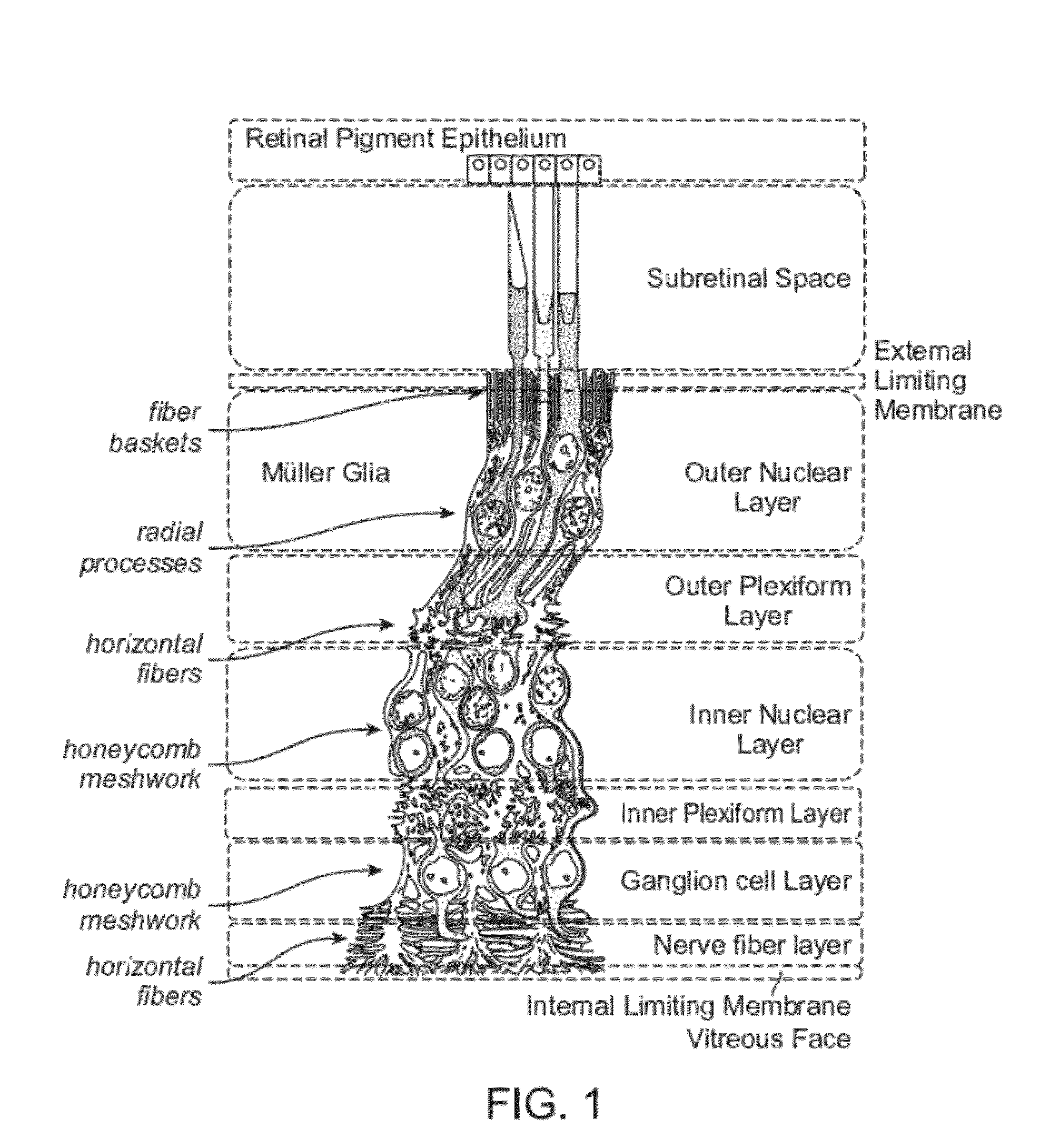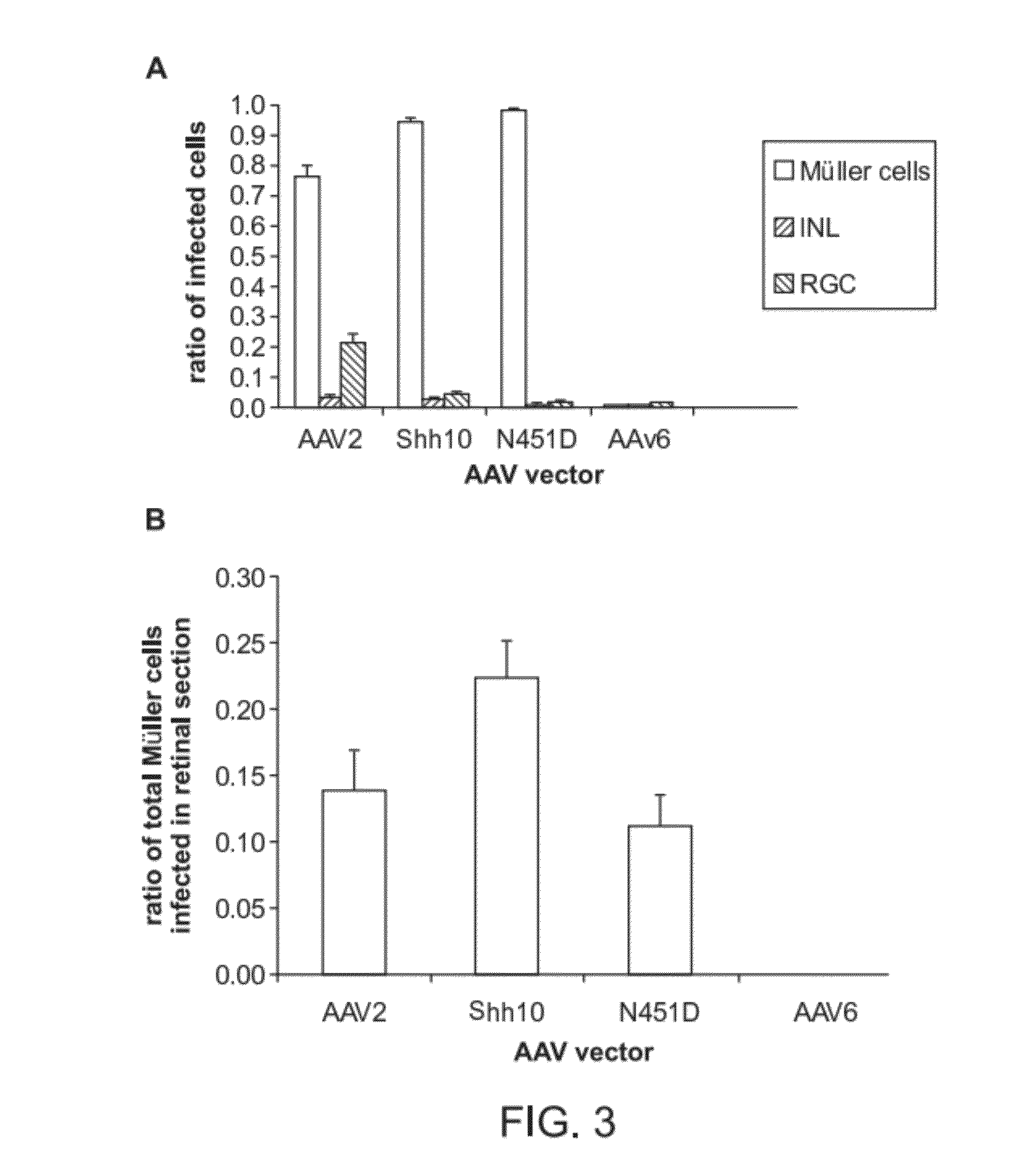Adeno-associated virus virions with variant capsid and methods of use thereof
a technology of adenovirus and variant capsid, which is applied in the direction of non-active genetic ingredients, peptides, drug compositions, etc., can solve the problems of limited individualized treatment options for afflicted patients, inefficient cost, and vectors ineffectively infecting müller cells via intravitreal injection
- Summary
- Abstract
- Description
- Claims
- Application Information
AI Technical Summary
Benefits of technology
Problems solved by technology
Method used
Image
Examples
example 1
Generation of rAAV Virions with Variant Capsids and Exhibiting Increased Infectivity of Müller Glial Cells
Materials and Methods
Generation of rAAV Vectors
[0122]Vectors were produced by the plasmid co-transfection method (Koerber et al. (2009) Mol. Ther. 17:2088), and the resulting lysates were purified via iodixanol gradient ultracentrifugation as previously described. Koerber et al. Mol Ther. 2008; 16:1703-1709. This fraction was then passed through a heparin column, which was washed with 5 mL phosphate-buffered saline (PBS) and eluted with 5 mL of a 1 M NaCl solution. The resulting viral fractions were desalted and concentrated with Amicon Ultra-15 Centrifugal Filter Units to a final volume of 200 μl. Vector was then titered for DNase-resistant vector genomes by real time polymerase chain reaction (PCR) relative to a standard.
Intraocular Administration Routes
[0123]Adult wild type Sprague Dawley rats were used for the studies discussed in this Example. All animal procedures were con...
example 2
AAV-Mediated GDNF Secretion from Retinal Glia Slows Retinal Degeneration
Materials and Methods:
[0143]Generation of rAAV Vectors:
[0144]AAV vectors were produced by the plasmid co-transfection method. Grieger et al. (2006) Nat Protoc 1: 1412-1428, rAAV was purified via iodixanol gradient ultracentrifugation (Dalkara, D, et al. (2009) Mol Ther 17: 2096-2102) and heparin column chromatography (GE Healthcare, Chalfont St. Giles, UK). The viral eluent was desalted and concentrated with Amicon Ultra-115 Centrifugal Filter Units to a final volume of 200 μl and titered by quantitative polymerase chain reaction (qPCR) relative to standards.
[0145]Intraocular Injections:
[0146]TgS334-4ter rats were used for all studies, and all animal procedures were conducted according to the ARVO Statement for the Use of Animals and the guidelines of the Office of Laboratory Animal Care at the University of California, Berkeley. Rats were first anesthetized with ketamine (72 mg / kg) and xylazine (64 mg / kg) by in...
PUM
| Property | Measurement | Unit |
|---|---|---|
| time | aaaaa | aaaaa |
| time | aaaaa | aaaaa |
| time | aaaaa | aaaaa |
Abstract
Description
Claims
Application Information
 Login to View More
Login to View More - R&D
- Intellectual Property
- Life Sciences
- Materials
- Tech Scout
- Unparalleled Data Quality
- Higher Quality Content
- 60% Fewer Hallucinations
Browse by: Latest US Patents, China's latest patents, Technical Efficacy Thesaurus, Application Domain, Technology Topic, Popular Technical Reports.
© 2025 PatSnap. All rights reserved.Legal|Privacy policy|Modern Slavery Act Transparency Statement|Sitemap|About US| Contact US: help@patsnap.com



